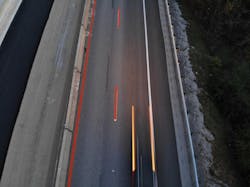Orange Markings in Work Zones
Even though work zones are a necessary part of maintaining and upgrading our nation’s highways, they continue to cause congestion and crashes. While technologies of various types have been implemented to create smart work zones, the congestion and crash data persist. An innovative work zone approach that is being tested in multiple areas around the country is the use of orange pavement markings.
Orange pavement markings are intended to provide delineation while reminding drivers they are in a work zone. Orange pavement markings are currently being studied to determine if they can mitigate driver confusion to common pavement marking obliteration practices and raise drivers’ awareness of the work zone. Orange pavement markings have also been used to help improve visibility when salted winter roadways make white markings difficult to see.
If you travel in and around Toronto or Quebec, you have probably seen orange markings in work zones; this is where they have been used the longest (at least in North America). In the U.S., Wisconsin was the first state to try orange markings. Currently, Texas and Kentucky are evaluating orange markings. The state of California is preparing to also install orange markings in the San Diego area. In the U.S., as per the MUTCD, agencies must request permission from FHWA to use/experiment with orange markings. Some agencies supplement orange markings with orange raised retroreflective pavement markers.
While orange markings are intended to help the human driver travel through work zones, a study in Europe has shown that orange markings may also be advantageous from an automated vehicle perspective. It turns out that orange colored markings are more detectable for LIDAR systems than white or yellow markings. As automated vehicles become more mainstream, we may begin to see more orange markings through work zones. This could be just one of many potential impacts of automated vehicles.
The following gallery shows various aspects of the application test of orange pavements markings on a road project in Kentucky.
